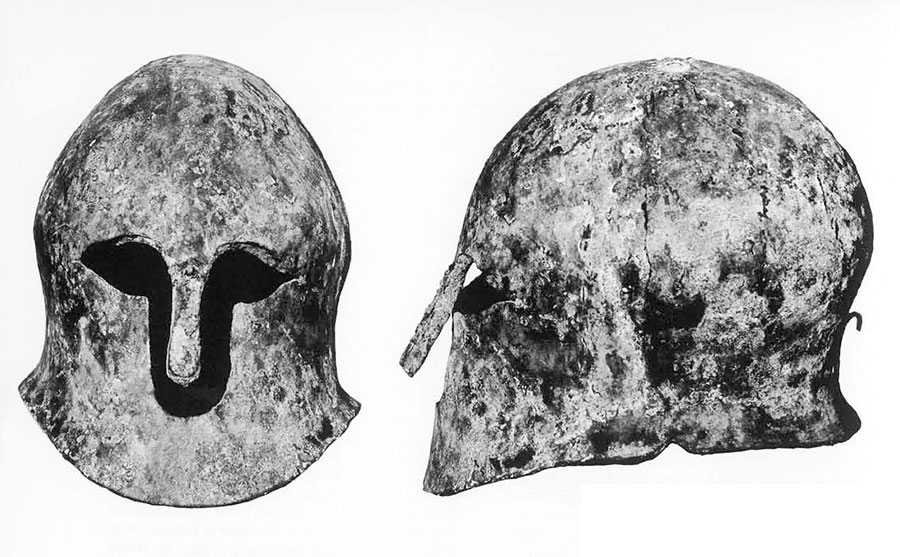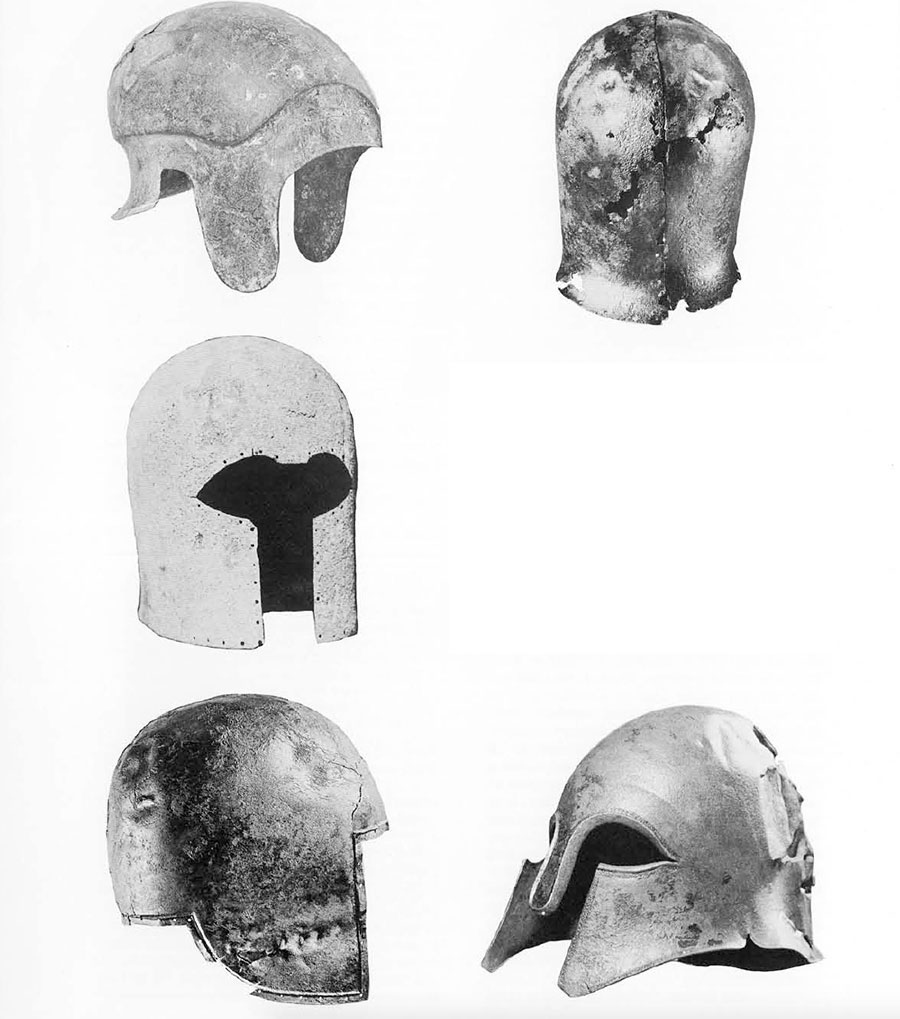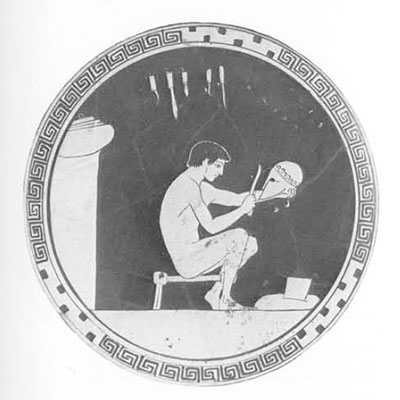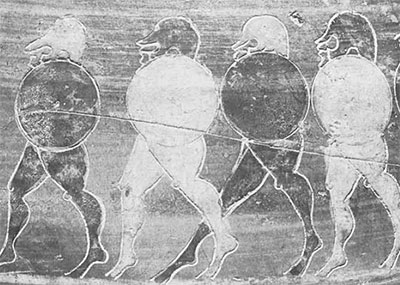She found him sweating as he turned there and there to his bellows busily, since he was working on twenty tripods which were to stand against the wall of his strong-founded dwelling. And he had set golden wheels underneath the base of each one so that of their own motion they could wheel into the immortal gathering, and return to his house: a wonder to look at. These were so far finished, but the elaborate ear handles were not yet on. He was forging these, and beating the chains out. As he was at work on this in his craftsmanship and his cunninc meanwhile the goddess Thetis the silver-footed drew near him.
So he spoke, and left her there, and went to his bellows. He turned these toward the fire and gave them their orders for working. And the bellows, all twenty of them, blew on the crucibles, from all directions blasting forth wind to blow the flames high now as he hurried to be at this place and now at another, wherever Hephaistos might wish them to blow, and the work went forward. He case on the fire bronze which is weariless, and tin with it and valuable gold, and silver, and thereafter set forth upon its standart the great anvil, and gripped in one hand the ponderous hammer, while in the other he grasped the pincers.
He spoke, and flashing forward laid hold of the horse-haired helmet and spun him about, and dragged him away toward the strong-greaved Achaians, for the broidered strap under the softness of his throat strangled Paris, fastened under his chin to hold on the horned helmet.
She broke the chinstrap, made from the hide of a slaughtered bullock, and the helmet came away empty in the heavy hand of Atreides. The hero whirled the helmet about and sent it flying among the strong-greaved Achaians, and his staunch companions retrieved it.

The excellence and the wide-spread diffusion of ancient Greek armor are well known. Some of the most numerous examples extant are the Corinthian helmets of which there are well over three hundred specimens scattered among various museums–a number which is being rapidly augmented by the newly discovered helmets in Olympia, especially those from the seemingly inexhaustible Alpheys River. The functional beauty of this armor was recognized early in the ancient world, and the exportation of Greek weapons to the various parts of the then known world was a usual feature in the eighth century B.C.

Since the standard of Greek metal-work was high, as we know for example from the descriptions in the Iliad, and since information concerning smithies in that early age in other parts of the ancient world is fragmentary, one tends to underestimate the contributions of other nations to this ancient craft. That Greek-type armor made elsewhere than on Greek soil sometimes attained a very high quality is attested by two superb Italo-Corinthian helmets in the University Museum. They were executed within two centuries of each other and show the development of this type of headpiece in Italy. They were described forty-three years ago by Stephen B. Luce in the Museum Journal, Vol. 11, No. 1, and have been referred to in various publications. In view of the numerous examples found, mostly in Olympia, and published by e. Kunze (Berichten uber die Ausgrabungen aus Olympia, Vols. 1-7) since the article by Dr. Luce, our knowledge of this type of armor has been greatly increased.
The name “Corinthian” appears first in Herodotus (Book IV, 180), indicating not only the type of helmet but its provenance as well. In speaking of the Machlyes, he says: “They hold an annual festival in honour of Athene, at which the girls divide themselves into two groups and fight each other with stones and sticks…Before setting them to fight, they pick out the best-looking girl and dress her up publicly in a full suit of Greek armour and a Corinthian helmet; then they put her in a chariot and drive her round the lagoon.” This type of helmet is well known to us from the long series of representations of almost exclusively Corinthian helmets appearing first on Corinthian vases in proto-Corinthian times, the helmeted head of Athena on Corinthian coins, and the excavations at Corinth.
It seems plausible that the Peloponnesus, where the earliest Greek pot-helmet originated, and the city of Corinth with its highly developed metallurgy, should be the home of this helmet centuries before Corinth actually assumed its leadership in bronze casting. From Corinth the use of these helmets spread to various countries beyond the boundaries of the Greek world. Since proto-Corinthian was the earliest style in which engraving was regularly used on vases, with frequently occurring war episodes, the distinctive outline of the fully developed Corinthian helmet is easily recognizable. Consequently, we know that the helmet in its earliest form already existed in the early eighth century, a little before Late Geometric times. According to this chronology, its appearance also indicates the end of the heroic Geometric epoch and the beginning of the regular hoplite armies with their heavily armed foot soldiers.
Some degree of standardization of weapons and a special pride in the form of the Greek helmet as a national symbol are manifested by the fact that colonies continued to use the helmet design of their mother-towns. It is quite natural that places outside the Greek communities were captivated by the simplicity and purposefulness of the Greek weapons.

The first of the University Museum helmets (MS-1608) represents an ingenious Italic imitation of the earliest known Corinthian helmet. The massive imposing planes do not closely follow the head contour, as they do on Greek prototypes on which the back had already assumed, in early proto-Corinthian times, a reversed “S” shape. The lower section of this flexure, which usually rests on the shoulder, meets the bowl-shaped back of this helmet in a sharp corner. The extraordinarily large size of the helmet required a lining, probably of sponge or felt. Imprints on the surface and the formation of the patina also indicate the presence of such a lining. On the other hand, the complete absence of holes around the cheek pieces and eye openings for attaching the lining raises some doubt. May perhaps a close-fitting cap of sponge or felt have been worn under the helmet but not attached to it?
The helmet, including the nasal guard, was hammered from one large sheet of bronze, the actual shaping being done on a stake. The annealing process, through which the hammer marks were made to disappear, is of high quality; the smooth surface suggests the highly accomplished finishing operation performed on most helmets by such very effective abrasive materials as leather-covered wooden wheels. Its perfect preservation indicates a water grave as its finding place. Altogether, this is one of the best preserved specimens of this type known to us.
Its place of origin is not recorded, but similar examples come from several North Italian graves, particularly from Lombardy. That it was hammered from one piece of metal is an unusual feature for this type of Italic helmet, since they were usually made of two sections and pressure-welded along a horizontal line, as was frequently done with mainland Greek helmets. (Sometimes two vertical sections were welded or riveted together along a vertical line, an arrangement which greatly facilitated the work of the armorsmith.) On this basis and on stylistic grounds, it resembles other helmets of Italian provenance, examples of which may be found in the Louvre and in the Staatliche Museum zu Berlin.
The robust, well designed primitive planes, the bulging of the lower section created by the steeply descending divergent cheek pieces, and the non-aligned ellipsoid eyes (in contrast to the round regulated Greek eye openings concurring in an angle) all expose disparate barbaric influences and are quite alien to Greek taste. But the helmet does show general relationship to the helmets of the late eighth and seventh centuries. However, while the earliest Corinthian helmet had little or no nose guard, here the sophisticated nasal piece and the thick metal construction suggest a date not earlier than the first quarter of the seventh century.
Unfortunately, the chronology applied to Greek helmets cannot safely be related to Italic headpieces, although the earliest dates are easier to specify than the later ones. Provincial repetitions of Greek-type weapons are known from the early eighth century; for instance, the so-called Illyrian helmet appears simultaneously in the remote barbarian-inhabited northern areas of the Balkans and the Greek-inhabited southern areas of this peninsula. Strange recurrences of certain types of weapons, anachronisms recalling the ancient glory, and frequent representation of early Greek heroes in contemporary armor, lead to error in determining the age of weapons. Even deductions based on material evidence can sometimes be erroneous, since vase paintings and sculptures were subject to the whims of their creators. But this helmet and similar ones from North Italy show that the well developed armor styles, and probably the newly organized warfare which was to produce the hoplite armies, were adopted far beyond the boundaries of the Greek communities.
The second helmet (MS-1534) comes from Ascoli (Piceno) and, except for the missing crest and the reconstructed nasal piece, is well preserved. Although its general structure–the strongly accentuated “S” flexure which provided greater affinity with the shape of the head, the large eye opening belatedly suggesting the Daedalid tradition, the small triangular division on both side walls interjecting a logical separation between the cheek pieces–and its entire profile correspond to the development of the contemporary Corinthian helmet, it also has unique features which are characteristic of the Picenum area alone. The strongly protruding nose guard, which follows the natural bulging of the domelike crown, is reinforced inside with a metal band shaped somewhat like a butterfly. Its two arms, strengthening the plastically treated eyebrows, present the only decoration left on the austere headpiece. The most interesting addition, however–and absolutely unique among Corinthian helmets–is a bridge under the rounded nasal piece connecting the usually separated cheek pieces. This, with the emphasized eye openings, gives a somewhat fearful animalistic expression.
The purpose of the mouthpiece was to provide a more secure fit on the head; it replaced the leather chin-strap or laced thongs described in the Iliad. On most archaic helmets, holes for these attachments were not provided. Nevertheless, even though helmets were usually custom-made to fit individuals, most wearers felt the need for such an arrangement. This is the reason why many helmets have crudely punched holes in the lower corner of the cheek pieces, indicating the use of thongs which could be laced to hold the helmet securely on the head. Such holes are discernible until the last quarter of the sixth century, when this type of helmet lost its original function and was worn farther back on the head. Here is another indication of a practical shortcut by a local armor-smith which was never used on Corinthian helmets from Greek soil.


On the top of the helmet and on the back, remains of a crest holder can be seen. Although the Olympian excavations show that there was no decided pattern in regard to the crest of Corinthian helmets and that a broad variety of crest holder appears on other groups suggesting the same workshop, this method of attachment clearly indicates the longitudinal type of crest. As analogus helmets, with similar reinforcements around the eyes and with joined cheek pieces, are in the collection of the museum at Ancona, thier place of discovery is narrowed to the Picene area. Similar specimens outside of this area are not known, but heads with similar helmets occur on contemporary aryballoi. Parallel representations in vase paintings are also lacking; netiher were meticulous drawings with accurate descriptions of helmets showing decoration and holes in felt linings provided until the third quarter of the sixth century B.C., the time of Amasis and Exekias, some fifty years after the time of this helmet.
The well accentuated “S” curve of the profile and the parallel upper crown with its type of aperture indicate the final development of this style helmet. The strongly bulging dome of the helmet develops, at the end of the second quarter of the sixth century, into a protruding rim which separates the lower section of the helmet from the upper. This helmet is one of the last of its kind to occur before this change took place and is, therefore, to be dated to the end of the first quarter of the sixth century.

Several types of Italic helmets, together with imported ones, were commonly found in Villanovan and Picene graves, while more conservative ones occur frequently in Etruscan graves. To look for inspiration only to Magna Graecia would be inaccurate. Landing places along the Tyrrhenian Sea were engaged in wide commerce with the Aegean, decades before the foundation of Cumae, about 740 B.C., as the contents of the tombs show. In various parts of North Italy, Villanovans had already, over several generations, developed a metal industry under the inspiration of Central Europe. Before active organized traffic began, the armorer’s craft had been practiced in these regions on a high level, as evidenced by the frequently occurring shrapnel-shaped helmets, some of which had been hammered from one piece of metal long before the arrival of fashionable Greek types.
Traders reached the Italian coast quite some time before the Greek colonization. Phoenician, Cypriote, and Phocaean vessels brought their cargoes to some points of the Tyrrhenian shores where they traded popular Greek armor along with the staple products of the Aegean for raw material. During the archaic age of trade, helmets in particular had already reached distant points, as the archaic Jerez and Huelva helmets of Spain and the helmet of Ascalon in Israel reveal.
Another active traffic in arms during the early Iron Age was by way of the trade route in the Adriatic region, which passed through the Balkans and Lombardy overland and then by sea down along the eastern coast of Italy, which Trieste and Ancona as trading points. This traffic became the chief source of the large quantity of weapons found in Picene graves.
Some of the weapons and armor arriving in Italy were already barbaric imitations of Greek ones which had survived because of local preference in the Balkans long after their regular use in Greece had been discontinued.
With the foundation of Greek colonies in Magna Graecia, Greek armor gradually found its way directly to Central and North Italy. The great variety of weapons in graves–imports beside locally made imitations–shows that Picene and Etruscan warriors did not develop any definite preference for one type of armor, and, as a result, standardization of equipment did not become a keynote in the early armies of Italy. Once the pleasing, fashionable models found their way to the mainland, the inventive local armor-smiths modified them along simpler and more practical lines, only echoing the original pattern.
